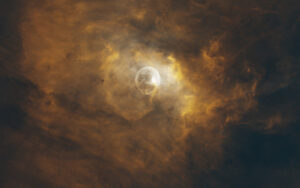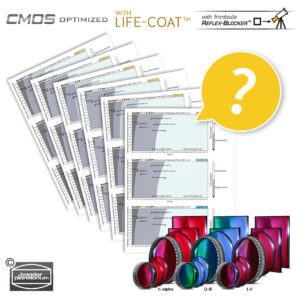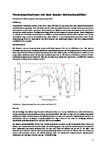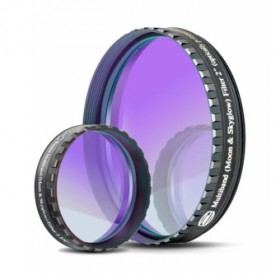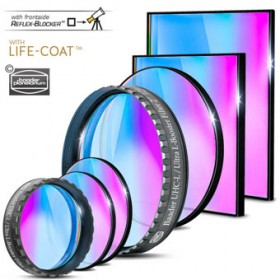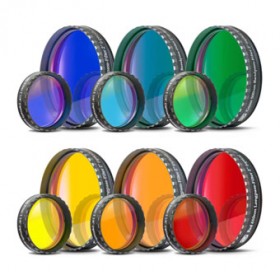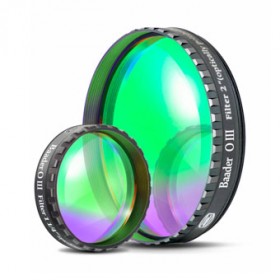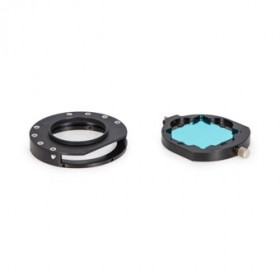- Home /
- Baader Methane-Filter 1¼" (889nm, 8nm)
Product Questions and Answers
Do you have a question about this product? Then we would like to ask you to first look through the existing questions and answers, most likely your question has already been answered and you will get the desired information much faster this way. Your question is not listed? Then please click on the button "Ask a question".
If you have not found a suitable answer, you can ask your question here.
For adapting any cell mounted Baader 2 inch Filter onto a camera lens with 52mm front filter thread you will need:
#2408166 Baader DSLR 2" Filter-Holder M48 / SP54: https://www.baader-planetarium.com/en/baader-dslr-2%22-filter-holder-m48sp54.html
#2958052 Baader Lens-Adapter-Ring SP54 / M52: https://www.baader-planetarium.com/en/baader-hyperion-dt-ring-sp54m52-for-dtadapter-iiandiii-and-hyperion-eyepieces.html
Based on the SP54 thread, we offer many more adapters for various camera threads, our so-called Hyperion DT-rings. https://www.baader-planetarium.com/en/catalogsearch/result/?q=sp54
Both thread sizes come with our proprietary pitch - which is not the same for the female and male threads.
This is our own proprietary "emergency solution" for uniting a world were manufacturers all over the world copy from each other - to the point that there are almost a dozen different pitches in use for male and female threads. Traditionally US-companies used to do a UNF-based pitch and the rest of the world went for metric threads - but these do vary from 0.5 to 0.75.
For this reason it does not make sense to publish our non standard pitch because our pitch is made to cope with all existing metric and US-pitch standards - and as said - our solution has evolved from sheer necessity. It is a mixture of a queer pitch and under-/over-dimensioning . We will not want to declare this as a standard and get bashed up for it. It works for us and is a result of 20 years adaptation to fit our filters onto all crazy threads we have seen. And inspite of this - every now and then there comes another "dragonboat-eyepiece" were even our filters may not fit...
- Related Articles
-
Related Articles
-
APF-R : Absolute Point of Focus
APF-R goes online as official plugin in Adobe Photoshop Christoph Kaltseis is a Photoshop expert and an experienced astrophotographer. In recent years, he has developed APF-R (Absolute Point of Focus), an innovative image sharpening process in Photoshop that has attracted considerable interest among experts. The Hubble Space Telescope team has been using his method for over 2 years. Adobe Photoshop has now introduced the easy-to-use APF-R Photoshop CC plugin for Christoph's complex process. The tool sharpens images using APF-R with just a few clicks, even without much prior knowledge. The plugin has already proven many times that it can meet even the high quality standards in astrophotography. Read a very interesting in-depth interview with Christoph Kaltseis on Picture Instruments about his experiences in astrophotography. Christoph reveals the tricks he uses to get the finest details out of his stunning images: "The secret behind Christoph Kaltseis astro images" on Picture Instruments - News (picture-instruments.com) It's not everyday that one could find a new sharpening technique or algorithm that would increase the sharpness of delicate threads of a nebula or dust lanes at the bright centre of a galaxy without significantly increasing noises or over-saturating stars in astronomical images. So when APF-R... -
Review: visual usage of the Baader RGB-B CMOS Filter
March 2021: The idea behind the visual use of blue filters from RGB palettes is that they have much higher transmittances in the blue value and steeper curve slopes than the usual blue filters known from planetary observation - e.g. the Wratten 80A/B/C filters or also Baader's dark blue 435nm and light blue 470nm filters. A CCD or CMOS blue filter allows much more light of the blue reflection nebulae of our galaxy to reach the eye and at the same time filters out the stray light in the green and yellow very effectively. Based on these considerations, soon after the release of their new CMOS filter range, I asked Baader Planetarium if they would lend me a CMOS blue filter Baader RGB B-Filter – CMOS-optimized (various versions available) in all visually usable formats: 1¼" screw-in thread for eyepiece-side mounting, 2" screw-in thread for 2" eyepieces on telescopes as well as for lens-side mounting on binoculars up to 45mm aperture, and finally 65x65mm square for lens-side mounting on 60mm binoculars. I was preaching to the choir, because Baader was very interested in the visual possibilities of these filters. Within a few days I received a bulging package Especially for the... -
HALOS – viewed without prejudice
The moment you insert any type of filter into the optical setup, which consists of your specific camera, the appropriate flattener/reducer or coma corrector and the telescope, the filter becomes part of this unique optical system. And every optical system is different because many products from different manufacturers are involved. All optical surfaces interact with each other in some way. One possibility is that coatings of the camera reflect unwanted light back into the telescope and onto all optical elements in front of the filter. If there is no other optical surface that will reflect the light back to the filter a second time, then it is perfect. There are no halos other than residual halos or scattering, which are unavoidable, depending on the filter design. That's what we mean by our slogan "no halos, no ghosting, no reflections" on our product pages. A filter rarely produces halos itself, which are created inside the filter by internal reflections (this happened to us once in 2015, but we replaced all of these filters). Because the moment there are other surfaces near the filter, it is much more likely that light will be reflected from one of those surfaces, creating halos that... -
Information about Baader Filters and Filtercells
About Baader Filters The variety of uses for filters in amateur astronomy has considerably increased during the last decade, enabled by both more accurately manufactured optical accessories, and, above all, by the “digital revolution“. In the old days, colour filters for visual planetary observations were not screwed in the front part of the eyepiece, but were simply placed between the eyepiece and the eye. Plane-parallelism of these filter glasses was not important, because they were not in the optical path of the telescope. Today, filters are placed in the optical path of the telescope, even well in front of the focal plane. This definitely requires some degree of plane parallelism and accurate production of the filter glasses. Every single cell mounted filter delivered to our customers is cut as a round or square disc in the according size (1¼", 31mm, 36mm, 2", 50,4mm, 50x50mm, 65x65mm), and then is polished plane to a quarter wavelength on both sides on a computer numerically controlled polisher. After that, the polished blanks are submitted to the costly coating procedures. This sequence is also used for all unmounted filters. We deliberately avoid cutting filters from larger sheets, because the coating layers can be damaged at the edges and suffer from microscopic... -
Baader CMOS Optimized Filters: Unleashing the Full Potential of Astrophotography
What do you look for in an astronomical filter? Everyone has different requirements and goals and with a myriad of filters available today; how do you choose the right filters to unleash the full potential of Astrophotography? In this blog our customer Ian Aiken gives some high level advice on what to look for when choosing a filter, coupled with reasoning why he choose the Baader's CMOS-Optimized LRGB and Ultra Narrowband f/2 filters, along with example LRGB and SHO images taken with these filters on his Celestron RASA 11 from his Bortle 7 suburban location. New CMOS-optimized Baader filters Blog Post by Ian Aiken: I live in the North East of England in the United Kingdom, which experiences a temperate maritime climate characterized by mild summers and cool winters. Cloudiness can vary throughout the year and it feels like I only get 20 usable clear nights per year at my Bortle 7 location during the 6 months where astronomical darkness actually occurs. I've been an Astrophotographer for over 20 years and I've had all kinds of telescopes, mounts, filters (including Optolong, Astro Hutech, Chroma, Baader) and cameras (Atik, QHYCCD, ZWO, Canon) in this time, for both planetary and deep sky...
-
Additional Information
| Manufacturer | Baader Planetarium |
|---|---|
| SKU (#) | 2458295 |
| EAN Code | 4047825023285 |
| Net weight (kg) | 0.06 |
| Transmission Range | Methan |
| Filter Thickness (without cell) | 2 mm |
| HBW (Halfbandwidth) | 8nm |
| CWL (Central Wavelength) | 889 nm |
| AR-Coating | dielectrically coated, planeoptically polished |
| Filter size | 1 25 inch |
| Filter Usage | CCD, Planetary, Specialty |
| Filter mounted | Mounted (LPFC 6mm) |
| Type of Filter | Narrowband |
| Single or Set? | Single Filter |
| Filter shape | round |
FAQ
-
Please click on title to open or open/close all FAQs
-
HALOS – viewed without prejudice
What do you look for in an astronomical filter? Everyone has different requirements and goals and with a myriad of filters available today; how do you choose the right filters to unleash the full potential of Astrophotography?
In this blog our customer Ian Aiken gives some high level advice on what to look for when choosing a filter, coupled with reasoning why he choose the Baader's CMOS-Optimized LRGB and Ultra Narrowband f/2 filters, along with example LRGB and SHO images taken with these filters on his Celestron RASA 11 from his Bortle 7 suburban location.

New CMOS-optimized Baader filters
Blog Post by Ian Aiken:
I live in the North East of England in the United Kingdom, which experiences a temperate maritime climate characterized by mild summers and cool winters. Cloudiness can vary throughout the year and it feels like I only get 20 usable clear nights per year at my Bortle 7 location during the 6 months where astronomical darkness actually occurs. I've been an Astrophotographer for over 20 years and I've had all kinds of telescopes, mounts, filters (including Optolong, Astro Hutech, Chroma, Baader) and cameras (Atik, QHYCCD, ZWO, Canon) in this time, for both planetary and deep sky photography. Financially, I've learnt the hard way through fine tuning my current collection to something which supports my sky conditions, budget, time, and imaging goals.
Currently I own a Skywatcher EQ8 mounted in my roll off roof observatory. On this I have a RASA 11 with Baader UFC, QHY268M camera and Baader's CMOS-Optimized LRGB and Ultra-Narrowband f/2 filters.
Here are the factors I've considered when choosing my filters:
- Price:
Assess the price of the product in relation to its features, quality, and performance. Is the price reasonable and competitive compared to similar products in the market? Consider whether the product offers significant advantages or unique features that justify its price.
In my opinion, Baader filters are absolutely value for money. They've kept the price competitive and performance high. A set of Baader filters costs a little more than a single Chroma. Chroma are good, but did not feel value for money in comparison (Baader 2" LRGB set ~ € 500 vs. Chroma LRGB ~ € 2.238). - Quality:
Examine the quality of the product. Does it meet your expectations in terms of durability, craftsmanship, and overall build quality? A product that is well-made and built to last will provide better long-term value.
Baader CMOS-Optimized filters come with Baader Planetarium's Life-Coat technology. Baader warrant the coatings for the life of the filter guaranteeing that the coatings will not peel, flake or physically degrade and they have no issues with you cleaning the filters with fine optical cleaning equipment. You can see the build quality is high, the coatings look durable, and I can understand how Baader can offer such a life time warranty. I don't think anyone else offers this. - Performance:
Evaluate how well the product performs its intended function. Does it deliver the expected results or fulfil your requirements? Consider its efficiency, accuracy, reliability, and any additional benefits it provides compared to alternative options.
I'm going to post some images later in this blog, and you can judge the quality for yourself. Yes, there were initial problems with halos and these have been resolved. I haven't had any issues that I am concerned about. Halos can be a real pain, and it's not always the filter that causes this (most cases it is not the filter). Reflections can occur in your imaging system and could be caused by a number of factors: including spacing between optical elements; distance to CMOS camera; the CMOS camera front window itself etc. You have to spend time to understand your entire optical system and its individual nuances. - Features and Specifications:
Review the features, specifications, and capabilities of the product. Are there any unique or advanced features that differentiate it from competing products? Determine whether these features are essential to your needs and whether they justify the price.
I opted for high-speed ultra-narrowband to match with my RASA 11. This was based upon my needs (explained a bit further below). In terms of features, what stood out was the features integrated into the filters to help prevent reflections and halos. For instance:
- Reflex-Blocker - with coatings to reduce halos caused by my imaging system.
- Parfocal - this helps to not have to refocus so much during a filter change. As a filter change is manual on my RASA 11 with the Baader UFC system, it means less movement with my motorised focuser and I am back to imaging quicker (and the focuser isn't off on some mission to reach focus by going further out of focus, which can happen when using an SCT type design).
- Blackened edges - again to help reduce reflections in my imaging system, lots of mirrors and glass = high potential for reflection
- Sealed Coating Edge - each filter is coated individually and not cut from a sheet. This is probably why they will last forever, and Baader are able to offer Life-Coat warranty.
- Brand Reputation and Customer Reviews:
Research the brand's reputation and customer reviews of the product. Look for feedback from other customers who have used the product to gain insights into its performance, reliability, and customer satisfaction. Positive reviews and a strong brand reputation can indicate better value for money.
Baader Planetarium have been in business since 1966. I've never experienced any poor customer care from dealers or Baader directly (I admit, I've not really had any issues either, with exception of one issues with the early Baader Steeltrack software which was swiftly resolved by Baader themselves). As a family run business, I feel they are passionate with what they do, and want to do the right thing at the right price, making astronomy accessible to all budget types, and truly are Aiders in Astronomy (this is their slogan).
- Longevity and Future Compatibility:
Consider the product's longevity and future compatibility. Will it remain relevant and usable for a reasonable period? Assess whether the product is upgradable or compatible with future advancements or technologies to ensure its value over time.
I have the older Baader 2" CCD filters which are in the same condition that I purchased them in. I have no concerns about the longevity of the Baader CMOS Optimised filters, especially backed by the Life-Coat warranty. 2" filters are going nowhere, and while the sensors on modern CMOS cameras are getting larger, I cannot see the need to upgrade anytime soon. I've been using 2" filters for the past 20 years.
- Warranty and Customer Support:
Evaluate the warranty offered by the manufacturer and the availability of customer support. A reliable warranty and responsive customer support can provide additional value by offering peace of mind and assistance in case of any issues or defects.
Baader offers Life-Coat, a lifetime warranty on their CMOS-Optimized filters (providing used and handled correctly). As a family run business operating for over 50 years, Baader are trustworthy and offer great customer support.
- Personal Needs and Preferences:
Finally, consider how well the product aligns with your specific needs, preferences, and intended use. Different products may cater to different requirements, so it's essential to choose one that best suits your circumstances and priorities.
What did I choose?
I decided on the Ultra Narrowband High-Speed filters on my RASA 11. Why? Well, the reasoning may surprise you. While the filters are excellent value for money, my garden backs onto other gardens and my neighbours have lots of LED lights lit, especially on weekends when it's not windy, the moon is not out, and the sky conditions are good. You can picture the challenges already. Also, there are trees which do not belong to me which get in the way. I work full time, and have two small children, time is limited. I'm middle-aged, but not retired, so I cannot stay up all night imaging into the early hours. So, I went for a RASA for high speed imaging, reducing my imaging time significantly. While I may image across multiple nights, I don't need to. It just works for my current situation. The Baader filters are brilliant on the RASA 11, and I'm able to produce some excellent results (see further in the blog) even with all my challenges.
I hope the above helps you make a decision on what filters would be good for your needs. Baader Planetarium has a really nice tool to help you match which filters would be best for your imaging system. At time of writing you can access this tool: Baader Narrowband-/Highspeed Filter Selector
Example of Astrophotography taken with Baader CMOS Optimized Filters
I could talk about how tight the stars are (they are), how the filters have much more contrast than their predecessors (they do), but this can still be very subjective and influenced by sky conditions. My skies aren't great, they really aren't, and I have to battle with all the other issues living in a suburban environment. These images were also shot in reasonably poor conditions with thin haze. I also have to point out that I don't spend a massive amount of time processing my images. I think partly, if you capture good data you can produce a good image. You don't, in my opinion, need to push an imagine in processing so that it looks so bright and colourful. To me this looks over processed, and I prefer the darker looking style images with simple histogram and curves transformations. There's the disclaimers out of the way.
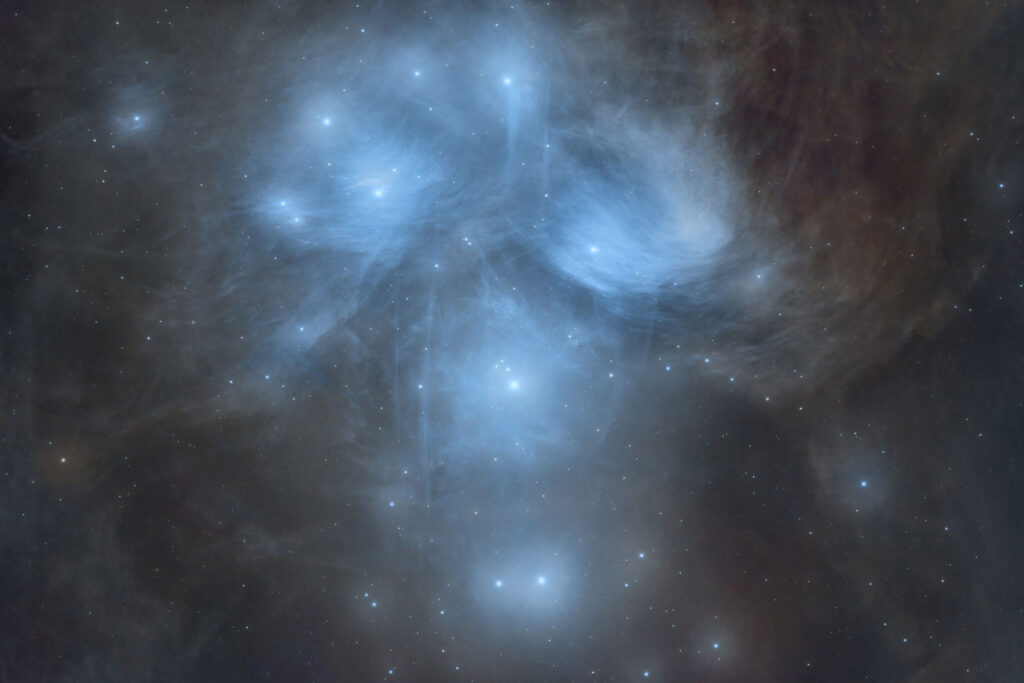
My workflow consists of using PixInsight to Calibrate, Stack, Automatic Background Neutralisation, BlurXterminate, NoiseXterminate, and maybe StarXterminate. I may use TGV Denoise post stretching but haven't on these examples. I simply use the ScreenTransferFunction (STF) in PI applied to the Histogram, and a hint of Curves Transformation before exporting off into a PNG/JPG. There's probably so much more I could do, but I don't. Oh, I nearly forgot. I do use PhotometricColorCalobration in PixInsight, which applies a white balance to the image.
NGC 7023 - The Iris Nebula 2 hour integration from Bortle 7 sky
NGC 7023, also known as the Iris Nebula, is a captivating and visually striking celestial object located in the constellation Cepheus. This reflection nebula lies approximately 1,300 light-years away from Earth, and its unique features have made it a favourite target for amateur and professional astronomers alike. The Iris Nebula gets its name from the distinct shape and appearance of its central region, which resembles an iris or an eye. This prominent feature is created by a dense cloud of interstellar dust, which scatters and reflects the light emitted by nearby stars. The dust particles in the nebula also create intricate dark filaments, adding to its overall visual allure. At the heart of NGC 7023 lies a young star cluster, illuminating the surrounding gas and dust with its intense radiation. This interaction gives rise to the vibrant hues of blue and yellow seen in many astro photographs of the nebula.
Imaging System: QHY286M CMOS Camera mounted on RASA 11 with Baader UFC.
Filters: Baader CMOS Optimised LRGB
Mount: Skywatcher EQ8
Exposure Details: 30 x 60 seconds each channel (LRGB). Total 2 hours integration time from Bortle 7 skies.
NGC 7023 - Baader UV IR CMOS-Optimized used for Luminance in LRGB image. 
NGC 7023 - Baader R CMOS-Optimized 
NGC 7023 - Baader G CMOS-Optimized 
NGC 7023 - Baader B CMOS-Optimized 
NGC 7023 - LRGB with Stars (I'm not sorry for not pushing the colour on this) 
NGC 7023 - LRGB reduced Stars 
NGC 7023 - LRGB without Stars 
NGC 7023 - LRGB without Stars (OK - I pushed the colour saturation a little!) NGC 7635 - The Bubble Nebula 17 Hour Integration from Bortle 7 Sky
NGC 7635, famously known as the Bubble Nebula, is a captivating and visually stunning emission nebula located in the constellation Cassiopeia. Its unique structure and distinct appearance have made it a popular target for both amateur and professional astronomers. The Bubble Nebula derives its name from the spherical bubble-like structure at its center, which is created by the powerful stellar wind and radiation emitted by a massive, hot, and young central star. This star, known as BD+60 2522, is estimated to be several times more massive than our Sun and emits intense ultraviolet radiation, which ionizes the surrounding hydrogen gas. The ionized gas then emits light, creating the striking reddish glow seen in images of the nebula.
Imaging System: QHY286M CMOS Camera mounted on RASA 11 with Baader UFC.
Filters: Baader CMOS Optimised 3.5/4nm f/2 Ultra Highspeed (Ultra-Narrowband) filters.
Mount: Skywatcher EQ8
Exposure Details: Ha: 354x60s, SII: 121x60s & 104x120s, OIII: 175x120s. Total ~17 hours integration time from Bortle 7 skies.Don't ask why the varying exposure! I'd also like to collect more data on SII and OIII in due course given it's about half of what I planned and need. You can tell by the images more is needed. Maybe next time, right? Astrophotography is for life not just for Christmas, or something like that…
I mixed the combination using PixelMath in PixInsight.

NGC 7635 - Baader f/2 3.5nm Ha CMOS-Optimized 
NGC 7635 - Baader f/2 4nm OIII CMOS-Optimized 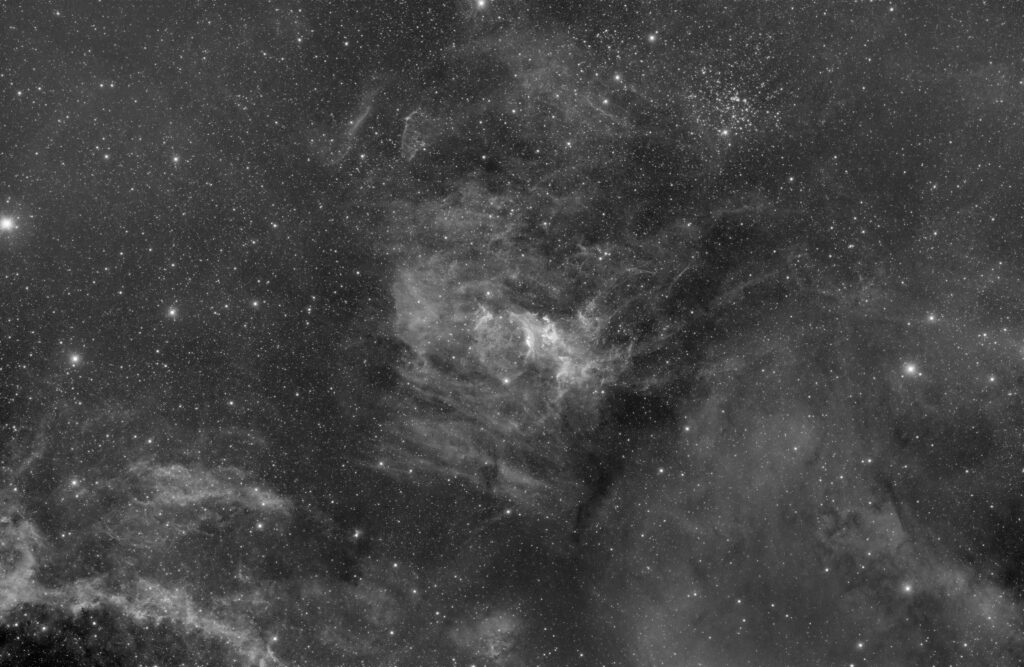
NGC 7635 - Baader f/2 4nm SII CMOS-Optimized 
NGC 7635 - RGB/SHO Combination with Stars 
NGC 7635 - RGB/SHO Combination with Reduced Stars 
NGC 7635 - RGB/SHO Combination without Stars 
NGC 7635 - RGB/SHO Combination Crop And finally to finish off, M45 taken with Baader CMOS-Optimized LRGB on same kits as above.
- Price:






